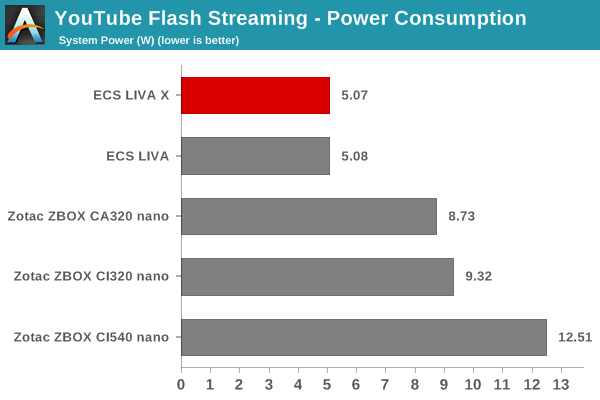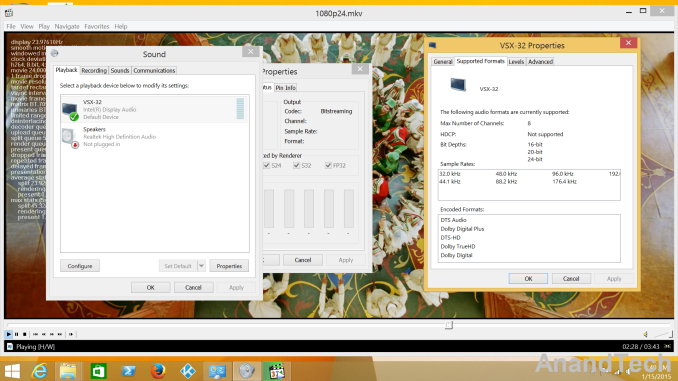ECS LIVA X Review: A Fanless Bay Trail-M mini-PC
by Ganesh T S on January 16, 2015 11:30 AM ESTHTPC Credentials
Given the ECS LIVA X's fanless nature and the presence of Intel HD Graphics, we expect most purchasers to use it as a media playback machine / HTPC. Given the specifications, it is quite clear that we are not looking at a madVR capable machine, but one targeted at the entry-level / average HTPC user or someone looking for a HTPC to put in a second or third room (non-primary HTPC). There are two HTPC aspects that we will explore in this section, one related to network streaming (OTT services), and the other related to local file playback. Prior to that, we have a small sub-section dealing with refresh rate accuracy.
Refresh Rate Accurancy
AMD and NVIDIA have historically been able to provide fine-grained control over display refresh rates. The default rates are also quite accurate. Intel used to have an issue with 23 Hz (23.976 Hz, to be more accurate) support, but that was resolved with the introduction of Bay Trail and Haswell. As expected, the ECS LIVA X has no trouble with refreshing the display appropriately in the 23 Hz setting.
The gallery below presents some of the other refresh rates that we tested out. The first statistic in madVR's OSD indicates the display refresh rate.
Network Streaming Efficiency
Evaluation of OTT playback efficiency was done by playing back our standard YouTube test stream and five minutes from our standard Netflix test title. Using HTML5, the YouTube stream plays back a 720p encoding, while Adobe Flash delivers a 1080p stream. Note that only NVIDIA exposes GPU and VPU loads separately. Both Intel and AMD bundle the decoder load along with the GPU load. The following two graphs show the power consumption at the wall for playback of the HTML5 stream and the Adobe Flash stream in Mozilla Firefox (v 35.0). The Flash plugin version used for benchmarking was 16.0.0.257. GPU load was around 36.04% for the HTML5 stream and 23.34% for the Flash stream.


Netflix streaming evaluation was done using the Windows 8.1 Netflix app. Manual stream selection is available (Ctrl-Alt-Shift-S) and debug information / statistics can also be viewed (Ctrl-Alt-Shift-D). Statistics collected for the YouTube streaming experiment were also collected here. GPU load in the steady state for the Netflix streaming case was 3.82%.

The ECS LIVA X easily manages to be the most power efficient of the passively cooled PCs that we have evaluated so far.
Decoding and Rendering Benchmarks
In order to evaluate local file playback in the ECS LIVA X, we concentrate on EVR-CP and Kodi. We already know that EVR works quite well even with the Intel IGP for our test streams. The decoder used was LAV Filters bundled with MPC-HC v1.7.7 for EVR-CP and hardware accelerated decoding enabled (default configuration) for Kodi 14.0
| ECS LIVA X - Decoding & Rendering Performance | ||||
| Stream | EVR-CP | XBMC | ||
| GPU Load (%) | Power (W) | GPU Load (%) | Power (W) | |
| 480i60 MPEG2 | 52.95 | 5.87 | 30.87 | 5.07 |
| 576i50 H264 | 48.12 | 5.81 | 56.95 | 5.81 |
| 720p60 H264 | 58.44 | 6.57 | 66.45 | 6.31 |
| 1080i60 MPEG2 | 85.72 | 7.96 | 82.44 | 7.21 |
| 1080i60 H264 | 95.96 | 8.62 | 86.87 | 8.09 |
| 1080i60 VC1 | 92.40 | 8.27 | 83.84 | 7.95 |
| 1080p60 H264 | 75.15 | 7.61 | 67.37 | 6.65 |
| 1080p24 H264 | 30.91 | 5.52 | 26.54 | 5.05 |
| 4Kp30 H264 | 81.67 | 7.83 | 45.93 | 6.05 |
The number of streams / decoder - renderer combinataions with issues is lower than what we had with the ECS LIVA - probably due to the slight bump in the clock speeds.
In our Zotac ZBOX CI320 nano review, I had erroneously mentioned that HD audio bitstreaming was not working for Bay Trail-M based systems. This turned out to be a pilot error - HD audio bitstreaming works if the drivers are directly downloaded off Intel's website.
In addition to usage as a HTPC / media playback machine with Windows 8 / 8.1, OpenELEC is also well supported for users who don't want to pay the OS tax. The ECS LIVA X is a nice little media playback machine with decent enough CPU performance for those who don't have too much 60 fps interlaced content.

















35 Comments
View All Comments
ozzuneoj86 - Saturday, January 17, 2015 - link
Seems a bit expensive for its capabilities. A 1.58Ghz Bay Trail is pretty slow for a non-mobile device.ganeshts - Saturday, January 17, 2015 - link
They run the CPU at 2.25 GHz (max. turbo speed) throughout the time the CPU is loaded. At this point of time, CPUs with such clocks are more than enough for thin-clients and basic browsing / word-processing [ well, that is what the market reception to the original ECS LIVA signified to ECS :) ]In the end, it is all a matter of 'horses for courses' - what fits the requirements of one person might be an overkill for someone else (isn't that why tablet PC sales have caused a decline in shipment of low-end notebooks / PCs?)
ozzuneoj86 - Saturday, January 17, 2015 - link
I see, I missed that about it running at its max turbo since it isn't limited thermally.I guess I just have trouble picturing the target market being anyone who actually knows what they are getting vs. what they need. Most of the places that I've seen thin clients used could easily just use a small ITX-sized desktop PC that is significantly faster, and (as is the case with this LIVA X) you generally pay a price premium for a thin client sized system. When you factor in the OS price, it seems unlikely that cost has anything to do with the purchase of a system like this, so that leaves size as the only real reason to get one.
My workplace replaced several Core 2 based itx-sized HP desktops a few years ago with these awful little WYSE thin clients. Everything takes longer, runs slower and now there is a tiny bit more desktop space for people to clutter paperwork that shoudn't be left out in the first place. I'm sure there will be some power savings, but it can't be much in relation to the cost of installing a bunch of new equipment, and they are already at their limit as far as capabilities. I give it another year before we have some new application that is too much for them to handle.
Obviously this LIVA system is faster, but it just doesn't seem like that many places are so constrained for space that PCs of this size are actually necessary, and for those that are, there are cheaper and faster alternatives, even at this price point (mostly due to the OS not being included).
kgh00007 - Saturday, January 17, 2015 - link
They need to sell a Windows 8.1 with Bing edition of these, the windows Licence increases the cost of the device by 1.5 times!!That's the biggest barrier to these cheaper mini PC's for me and for recommending them to anyone like family members!
Teknobug - Saturday, January 17, 2015 - link
hmm only dual core? I've been liking those Bay Trail Z37**'s.powerarmour - Saturday, January 17, 2015 - link
If a 59'C case temp isn't hot to touch, you probably need to visit the doctor!, 100'C core temps are ridiculous also, terrible design.ganeshts - Saturday, January 17, 2015 - link
The Zotac C-series with the Core i5-Y CPUs had chassis temperatures of the order of 75C. This is definitely much better.As for the 96 C core temp prior to throttling, there was a thermal pad placement issue in the media review samples. Seeing how this is similar to LIVA in terms of CPU performance and the fact that the material used for thermal protection is far superior, I have no doubt the units reaching the end user will have much lower core temperatures under *power virus* loads.
kmmatney - Sunday, January 18, 2015 - link
The temp is running furmark and Prime95 at the same time, which is a way higher load than normal. I've had computers that would crash while running that test, but were otherwise rock stable no matter what else I did.Oxford Guy - Monday, January 19, 2015 - link
Exactly. Who is ever going to use one of these for anything like that sort of load. It's bogus.BrokenCrayons - Tuesday, January 20, 2015 - link
I think the point of including an unrealistic scenario like furmark + prime95 is to stress the system in a way that induces a worst possible case situation. While most end users won't ever have that sort of thermal load on their hardware, doing this kind of testing in a review exposes potential flaws that wouldn't otherwise be discovered. I'd much rather someone does that kinda thing for me and uncovers a problem than having to figure it out for myself after I've made a purchase and have put it to use.